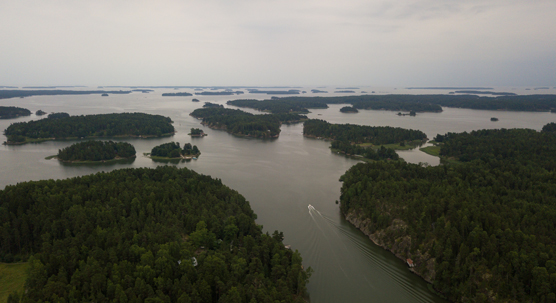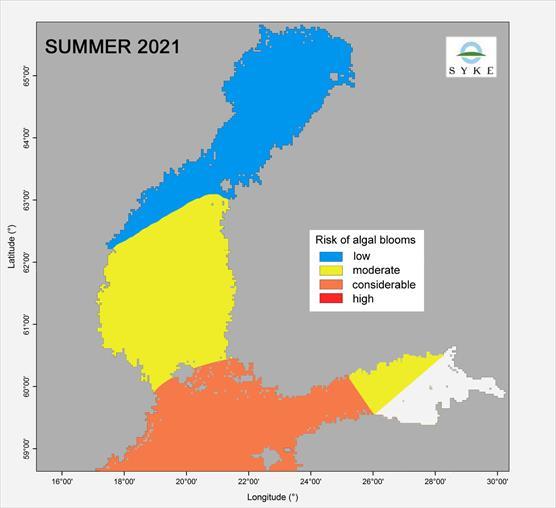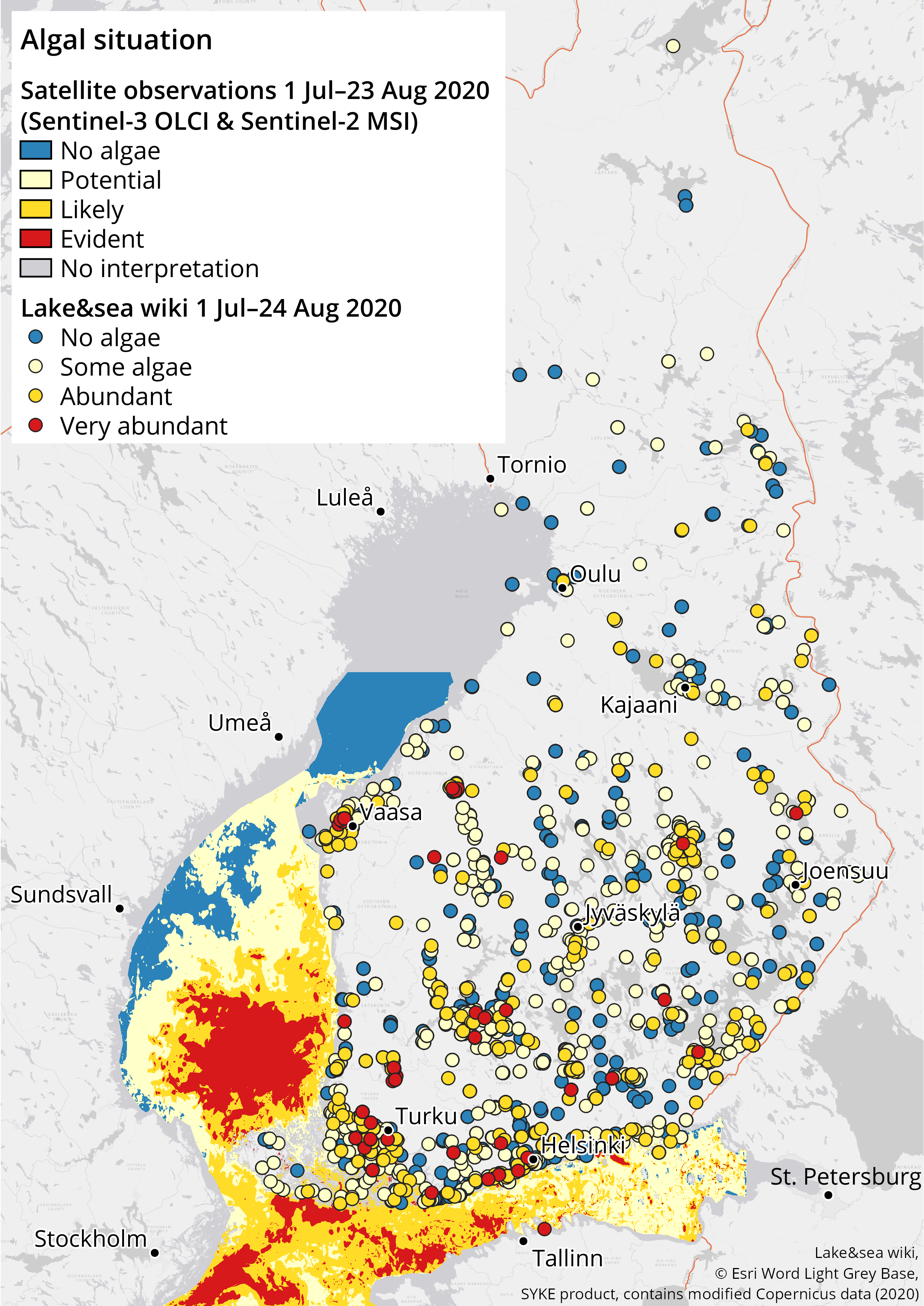Press release 2021-06-03 at 8:52

© Ilkka Lastumäki
The risk of significant and widespread cyanobacterial blooms this summer in the eastern Gulf of Finland and the main basin of the Baltic Sea is slightly higher than in summer 2020. In average summer weather conditions, the risk of algae is considerable in the northern part of the main basin of the Baltic Sea and in the Archipelago Sea. The risk of algae is moderate in the eastern part of the Gulf of Finland and almost the entire Bothnian Sea, and low in the Bay of Bothnia. The realisation of the risk is determined by the summer weather conditions as the nutrient situation in the northern part of the main basin of the Baltic Sea has not changed in recent years. Blooms in the Bothnian Sea have increased in recent years. Particularly favourable weather conditions, meaning warm and sunny weather, can cause significant cyanobacterial blooms; correspondingly, unfavourable weather causes considerably less cyanobacterial rafts.

The risk of significant and widespread cyanobacterial blooms this summer in the eastern Gulf of Finland and the main basin of the Baltic Sea is slightly higher than in summer 2020. © Kuva: SYKE
Basic conditions for cyanobacterial blooms in the Baltic Sea remain unchanged
The prime cause of cyanobacterial blooms is the nutrient situation in the Baltic Sea. Throughout the 2000s, the main basin of the Baltic Sea has been so nutritious that abundant cyanobacterial blooms have been possible. The nutrient situation in the main basin also has a strong impact on the Gulf of Finland. The abundance of blooms is mainly affected by summer weather conditions as cyanobacterial blooms need warm and sunny weather to emerge. In particular, the weather in July will determine the abundance of cyanobacterial blooms and the areas where most blooms occur. A sunny and warm July is also the best time for the growth of cyanobacteria.
The abundance of nutrients in the Baltic Sea is due to decades of nutrient load, and nitrogen and especially phosphorus have accumulated in the sea. The starting point for cyanobacterial growth varies somewhat from year to year. The main reservoir of nutrients is close to the bottom of the sea in deep water. The mixing of the nutrients with surface water varies according to autumn and winter weather and ice conditions. Although nutrient loads into the sea have clearly decreased in recent decades, the recovery of the entire Baltic Sea is slow.
The nutrient situation in the eastern part of the Gulf of Finland has improved over the last decade. By contrast, the situation in the Bothnian Sea has deteriorated. Significant cyanobacterial blooms have occurred in the Bothnian Sea in recent years. They have been caused by increased phosphorus concentrations in the Bothnian Sea, which is suspected to be due to increased deep water flows from the southern parts of the Baltic Sea main basin to the Gulf of Bothnia. The oxygen concentration at the bottom of the Bothnian Sea has been quite good, so that phosphorus that descends to the seabed with algal biomass can bind to the bottom sediment, unlike in the oxygen-free conditions of the main basin of the Baltic Sea.

Significant cyanobacterial blooms have occurred also in the Bothnian Sea in recent years. Summary of the cyanobacterial observations and surface algal areas interpreted from satellite observations during the summer of 2020. Blue-green algae observations: Lake&sea wiki, Nationwide algae monitoring. SYKE's remote sensing materials are licensed under the CC Name 4.0 International license. SYKE data, contains modified Copernicus data (2020).
Risk assessment for cyanobacterial blooms in the sea areas near Finland
The risk assessment of cyanobacterial blooms in the sea areas near Finland is based on the amounts of nitrogen and phosphorus available for the algae measured during the previous winter. Nutrient levels are mapped before algae start to take advantage of them in the spring. SYKE and the Swedish Meteorological and Hydrological Institute (SMHI) measure nutrient levels very comprehensively in the entire Baltic sea area during winter monitoring cruises. SYKE, together with the Finnish Meteorological Institute, assesses the risk of algae blooms using the Baltic Sea ecosystem model. In addition to the nutrient levels in the winter, the assessment takes into account the development of nutrient concentrations during the spring as spring water movements may change the overall picture. Spring nutrient information is obtained from SYKE's regular monitoring cruise and Alg@line monitoring on merchant ships at the end of April.
”The purpose of the assessment at the beginning of June is to remind particularly people moving in the sea and coastal areas of the start of the cyanobacterial blooming season. The regional risk assessment has remained fairly stable from year to year. An up-to-date picture of the algae situation can be obtained from SYKE's weekly algae reviews and by observing the situation yourself,” says Harri Kuosa, Leading Researcher at the Finnish Environment Institute. ”In particular, we have found that the cyanobacterial blooms in the Bothnian Sea have become more common. Phosphorus levels in the Bothnian Sea have increased considerably. Therefore, it is also important to make observations of cyanobacterial blooms in the Gulf of Bothnia."
Early summer weather will also have a big influence on the onset of cyanobacterial blooms. Generally, the amount of cyanobacteria usually increases after midsummer at the earliest, and blooming peaks in the Finnish sea areas are usually in July and early August. Algae rafts can still be seen during the autumn, but the wide blooms are then usually over. In the autumn, significant amounts of cyanobacterial blooms have occasionally been observed, especially in shallow bays. However, autumn cyanobacterial blooms that dye the shorelines occur usually only locally.
Winter rainfall and mild weather cause nutrient load from river waters to coastal areas. All nutrient loads are linked to eutrophication in the Baltic Sea. However, the impact of one winter on the summer cyanobacterial blooms is difficult to assess as phytoplankton consumes nutrients already in the spring. In spring, algae production is based on species other than cyanobacteria. One characteristic of spring algae species is their rapid descent to the seabed, where the decomposition of plankton mass increases oxygen consumption and thus phosphorus release. Thus, the nutrient load during winter also indirectly increases cyanobacterial blooms and maintains the general poor ecological status in Finnish sea areas.
Changes in the cyanobacterial rafts can be fast
Algae masses formed on the open seas move with sea currents. The movements of algae masses are assessed in the weekly overview of the cyanobacterial situation published by SYKE. Cyanobacterial blooms in the open seas can migrate to the southern part of the Archipelago Sea and to the coast of the Gulf of Finland, especially with southwest and southern winds. Long high-pressure weather maintains a constant cyanobacterial bloom. Strong winds can mix the surface water, making it difficult to detect a floating cyanobacterial raft. As the wind subsides, the cyanobacterial blooms accumulate back to the surface into a clearly visible raft, but this is not a sign of particularly fast growth of blooms. In autumn, cyanobacteria gradually die as the water cools and the amount of light decreases.
When you move around the sea areas, you may notice that the cyanobacterial blooms appear in patches. The amount of cyanobacterial blooms can vary a lot, even in small areas. Cyanobacterial blooms floating on the open sea often form clusters, but sometimes an entire sea area can be covered in blooms. Currents and wind can pile up cyanobacterial blooms in the coastal areas and the archipelago. Local nutrient sources, particularly phosphorus loads released from soft bottom mud in shallow coastal areas under poor oxygen conditions, can feed cyanobacteria during long windless and warm periods.
Cyanobacteria in the Baltic Sea can form a variety of toxins and skin irritants. Therefore, rich cyanobacterial blooms should always be treated with caution.
National algal reviews are published again
The Finnish Environment Institute reports on the cyanobacterial situation every week until the end of August. The first algal review for summer 2021 is published today, 3 June 2021 at 13:00.
Further information
Algal bloom risk assessment:
Harri Kuosa, Leading researcher, Finnish Environment Institute SYKE, tel. +358 (0) 295 251 106, e-mail: firstname.lastname@ymparisto.fi
Eija Järvinen, Communication Specialist, Finnish Environment Institute SYKE, tel. +358 (0) 295 251 242, e-mail: firstname.lastname@ymparisto.fi
Pictures for media use:
Links: